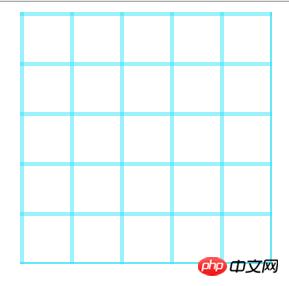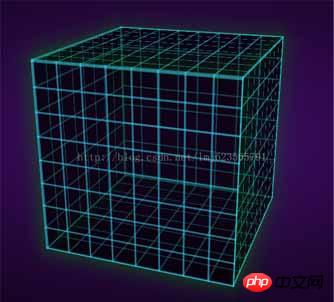
This article introduces an attractive example of HTML5+CSS3: 3D cube rotation animation example, the details are as follows
Rendering:

Knowledge points:
1. Review of perspective and transform
2. CSS3 backgroud realizes the grid background, that is, the small grid on the surface
3. @-webkit-keyframes implement animation
HTML:
<body>
<p class="stage">
<p class="cube">
<p class="font"></p>
<p class="back"></p>
<p class="left"></p>
<p class="right"></p>
<p class="top"></p>
<p class="bottom"></p>
</p>
</p>
</body>We have already mentioned how to make it in the previous 3D product display It's a cube, and there are numbers on it. Theoretically, it's more complicated than this, although it's not that cool~ I won't go into details here.
CSS:
html
{
background: -webkit-radial-gradient(center, ellipse, #430d6d 0%, #000000 100%);
background: radial-gradient(ellipse at center, #430d6d 0%, #000000 100%);
height: 100%;
}
.stage
{
-webkit-perspective: 1000px;
width: 20em;
height: 20em;
left: 50%;
top: 50%;
margin-left: -10em;
margin-top: -10em;
position: absolute;
}
.cube
{
position: absolute;
width: 100%;
height: 100%;
-webkit-transform-style: preserve-3d;
-webkit-transform: rotateX(-20deg) rotateY(-20deg);
}
.cube *
{
background: -webkit-linear-gradient(left, rgba(54, 226, 248, 0.5) 0px, rgba(54, 226, 248, 0.5) 3px, rgba(0, 0, 0, 0) 0px), -webkit-linear-gradient(top, rgba(54, 226, 248, 0.5) 0px, rgba(54, 226, 248, 0.5) 3px, rgba(0, 0, 0, 0) 0px);
-webkit-background-size: 2.5em 2.5em;
background-color: rgba(0, 0, 0, 0.5);
position: absolute;
width: 100%;
height: 100%;
border: 2px solid rgba(54, 226, 248, 0.5);
-webkit-box-shadow: 0 0 5em rgba(0, 128, 0, 0.4);
}
.font
{
-webkit-transform: translateZ(10em);
}
.back
{
-webkit-transform: rotateX(180deg) translateZ(10em);
}
.left
{
-webkit-transform: rotateY(-90deg) translateZ(10em);
}
.right
{
-webkit-transform: rotateY(90deg) translateZ(10em);
}
.top
{
-webkit-transform: rotateX(90deg) translateZ(10em);
}
.bottom
{
-webkit-transform: rotateX(-90deg) translateZ(10em);
}Similarly: stage serves as the stage, cube sets the effect of the child element to 3d, and then each face is rotated and Set translateZ and then form a cube.
Set the backgroud for each surface and set the code for small grids:
background: -webkit-linear-gradient(
left,
rgba(54, 226, 248, 0.5) 0px,
rgba(54, 226, 248, 0.5) 3px,
rgba(0, 0, 0, 0) 0px),
-webkit-linear-gradient(
top,
rgba(54, 226, 248, 0.5) 0px,
rgba(54, 226, 248, 0.5) 3px,
rgba(0, 0, 0, 0) 0px);
-webkit-background-size: 2.5em 2.5em;Background settings, 3 pixel strips from left to right , a 3-pixel strip from top to bottom; then set the background size to 2.5em 2.5em, and then repeat the background, the effect is as follows (I added a border):

Now the complete effect:

You can see that the cube has been formed, and finally add animation. Don’t think the animation is complicated, it is actually very simple~
Define an animation frame:
@-webkit-keyframes spin
{
from
{
-webkit-transform: translateZ(-10em) rotateX(0) rotateY(0deg);
transform: translateZ(-10em) rotateX(0) rotateY(0deg);
}
to
{
-webkit-transform: translateZ(-10em) rotateX(360deg) rotateY(360deg);
transform: translateZ(-10em) rotateX(360deg) rotateY(360deg);
}
}The name is spin, at the beginning translateZ(-10em) rotateX(0) rotateY(0deg); at the end: translateZ(-10em) rotateX(360deg) rotateY(360deg); That is, rotate 360 degrees around the x and y axes at the same time.
Finally add this animation attribute to our cube:
.cube
{
-webkit-animation: 6s spin linear infinite;
position: absolute;
width: 100%;
height: 100%;
-webkit-transform-style: preserve-3d;
-webkit-transform: rotateX(-20deg) rotateY(-20deg);
}Set the time to animation time 6s, animation spin, and speed to uniform linear , infinite loop infinite;
For more detailed parameter settings, you can refer to w3cSchool~In the future, I will also write a separate blog introducing the properties of CSS3~
Okay, the final effect has been completed ~
There is a slight difference in the appearance of the original website:
Because it adds an additional radial gradient to each face, then we add:
.cube *:before
{
display: block;
background: -webkit-radial-gradient(center, ellipse, rgba(0, 0, 0, 0) 30%, rgba(0, 128, 0, 0.2) 100%);
background: radial-gradient(ellipse at center, rgba(0, 0, 0, 0) 30%, rgba(0, 128, 0, 0.2) 100%);
content: '';
height: 100%;
width: 100%;
position: absolute;
}Use the before pseudo-element, and then set the radial gradient~~Now it is finally consistent~
Click to download the source code: demo
The above is I hope that the entire content of this article will be helpful to everyone's learning, and I also hope that everyone will support the PHP Chinese website.
For more articles related to 3D cube rotation animation, please pay attention to the PHP Chinese website!




